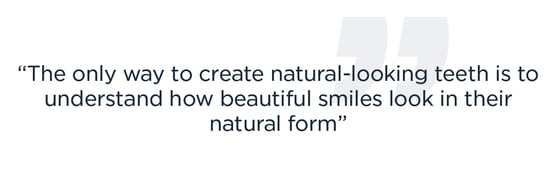Why are dentists still creating fake-looking restorations?

Studies have shown that as humans, our brains have evolved to instinctively identify things that look unnatural and false. While false appearances are typically associated with mistrust and potential danger, it is interesting to note that fake-looking teeth have always been a part of dentistry and are an accepted norm for many patients. The phenomenon of dazzling white and opaque, unnaturally shaped, and too symmetrical cosmetically restored teeth is fashionable and desirable to many, and yet there is a movement in dentistry that offers a more realistic option...
 DSD Natural Restorations is inspired by the natural imperfections found in all real teeth and, using facially driven planning, also ensures that the smile is in harmony with patient facial features and proportions. We asked Dr Angelo Raphael Coelho, DSD Planning Center and DSD Lab Director in Rio De Janeiro, Brazil, to tell us more about achieving natural-looking results for patients.
DSD Natural Restorations is inspired by the natural imperfections found in all real teeth and, using facially driven planning, also ensures that the smile is in harmony with patient facial features and proportions. We asked Dr Angelo Raphael Coelho, DSD Planning Center and DSD Lab Director in Rio De Janeiro, Brazil, to tell us more about achieving natural-looking results for patients.
Why have some dentists got into this habit of making fake-looking teeth?
Dr Angelo Raphael Coelho: This habit started because dental technicians were not able to create a true copy of natural shapes. They were always looking for the ‘perfect’ shape, but in natural teeth there are always natural imperfections and it’s impossible to reproduce them. Then dentists and patients became used to this pattern of fake perfection.

Why do you think some dentists believe fake-looking teeth are the ideal outcome?
Dr Angelo Raphael Coelho: They learned this from generations of dentists and dental technicians seeking perfection and not seeking to create really natural-looking teeth. Fake-looking teeth became the standard over the years.
Some dentists say that patients prefer fake-looking teeth. Where did this come from?
Dr Angelo Raphael Coelho: This trend is related to status. Some patients want to ‘show off’ their new smile to show that they can pay for expensive dental treatment. The same trend happened many years ago when having a gold filling signified financial status. However, on the other hand, we have patients now afraid of changing their smiles and having them look artificial. Today I'm seeing a greater demand for a more natural esthetic. I believe every dentist should understand that nature is our greatest reference for beauty.
When did this trend begin to change?
Dr Angelo Raphael Coelho: Trying to create a fake-looking smile has led some dentists to deliver restorations that don’t fit the patient's face. For example, extremely big teeth or shapes that stand out more than the patients would like, causing costly and time-consuming remakes. I believe this made people look for alternatives.
Is there a reason why dentists should still be creating fake-looking restorations in 2020?
Dr Angelo Raphael Coelho: Many scientific studies show that natural-looking teeth are more pleasing to the eye, even among lay people. Also, we should consider that today we have enough technology to help dentists and dental technicians to deliver natural-looking restorations that fit the patient's facial morphology. If dentists can show this to patients prior to treatment they are more likely to select a natural over fake-looking end result and also increase case acceptance. We definitely don't have any reason to deliver fake-looking teeth nowadays.
 How can a dentist know if the teeth they are creating look natural? What should they look out for?
How can a dentist know if the teeth they are creating look natural? What should they look out for?
Dr Angelo Raphael Coelho: The only way to create natural-looking teeth is to understand how beautiful smiles look in their natural form. When you use natural shapes to build a new smile you can really see the difference, but most importantly, the planning should be facially-driven. To summarize: DSD guarantees the facial integration and gives dentists access to a library of natural smiles to design natural-looking smiles.

How would you define DSD Natural Restorations? What, for you, makes a beautiful smile?
Dr Angelo Raphael Coelho: Technically speaking, Natural Restorations is defined as ‘facially driven monolithic restorations with natural algorithms’. When a dentist goes through the DSD stages of designing, planning and presenting the ideas for treatment, the patient becomes the co-designer of their new smile. When you add up all these factors, you will create a beautiful smile for sure.
Why are DSD Natural Restorations better looking in your opinion?
Dr Angelo Raphael Coelho: When you use the DSD Concept as the foundation for your treatment plan you have the advantage of creating a facially-driven outcome, so you know it is going to be in harmony with the patient's face. After selecting the correct proportions, the natural shapes will leave no doubt that the set-up achieved is right for that patient. The DSD Natural Restoration comes from a library of natural shapes obtained from the 3D scans of real patients. This provides the restorations with a natural morphology and surface texture.
How easy is it to start doing DSD Natural Restorations if you’ve never done them before?
Dr Angelo Raphael Coelho: Once a dentist understands the DSD Concept and related steps, it's easy to start using the DSD Planning Center services to create comprehensive and interdisciplinary treatment plans. If the case needs restorative ceramic work, this can be done using the DSD Natural Restorations. To achieve the highest outcomes possible with DSD Natural Restorations, the dentist has to be familiar with modern ceramic rehabilitation techniques. All of these steps, concepts and techniques are demonstrated at official DSD courses. There are specific courses that train dentists at every step of the way. To help you take advantage of all the potential of DSD Natural Restorations you can also outsource the manufacturing to the DSD Lab. The DSD Lab team will provide you with all tricks and tips necessary for the success of your case and you will have the peace of mind in knowing that you will be working with the most experienced team in this technique.
What is the most important thing every dentist should understand about DSD Natural Restorations?
Dr Angelo Raphael Coelho: The most remarkable feature of DSD Natural Restorations, besides them being a copy of real teeth and natural shapes, is that you already know the final result before going to the final restorations. Dentists wanting to use the DSD Natural Restorations workflow should take full advantage of the 3D planning, mock-up and temporary and preparation guide possibilities.
What should dental lab technicians know about DSD Natural Restorations?
Dr Angelo Raphael Coelho: Lab technicians willing to work with DSD Natural Restorations should understand that planning is the most important thing in the whole workflow. The planning should guide the preparation of the teeth, including preparation guides for the dentist. Once an adequate prep is achieved, the lab just has to mill, stain and glaze. If the technician tries to do too much adjustment, the natural shapes and natural surface texture can be ruined and that's no longer DSD Natural Restorations. So the lab technicians don’t need to improve the morphology after milling. They should not put your ‘signature’ on the final restoration.
How could dentists explain the benefits of DSD Natural Restorations to patients who insist on having fake-looking teeth?
Dr Angelo Raphael Coelho: Dentists don't need to worry about explaining why DSD Natural Restorations look better. Once they create a DSD mock up for the patient they will be showing the natural shapes in their mouth. That's when they should have a discussion about how the patient would like to proceed.
If you’re already convinced about the beauty of a natural-looking ‘imperfect’ smile, it’s time for you to join us on the DSD Natural Restorations course to put the theory into practice. This three-day program will give you all the knowledge you need plus vital hands-on experience (using a printed model) in how to follow the DSD concept to produce natural results – with clinical and patient satisfaction. You’ll also get to watch the full workflow in a live patient demonstration.
Join us on a DSD Natural Restorations course
Take a look at our website to see a breakdown of the course content and find upcoming dates which suit you. We hope to see you there!

